Wireless Communication: WiMAX, WPAN, and Energy Harvesting
VerifiedAdded on 2020/07/22
|8
|1590
|37
Report
AI Summary
This report delves into the realm of wireless communication, encompassing a comparison of encryption standards within WiMAX networks, a discussion of security challenges inherent in Wireless Personal Area Network (WPAN) technologies like Bluetooth and ZigBee, and a critical reflection on energy harvesting methods. The comparison of WiMAX standards highlights their key differences in coverage, bandwidth, and data rates. The report then identifies and explains security threats such as blue-jacking, blue-snarfing, and blue-smack in Bluetooth, and replay and physical attacks in ZigBee. Finally, it explores various energy harvesting techniques, including solar, piezoelectricity, and radio energy, discussing their potential for powering wireless sensor networks. The report concludes with a summary of the findings and a list of relevant references.
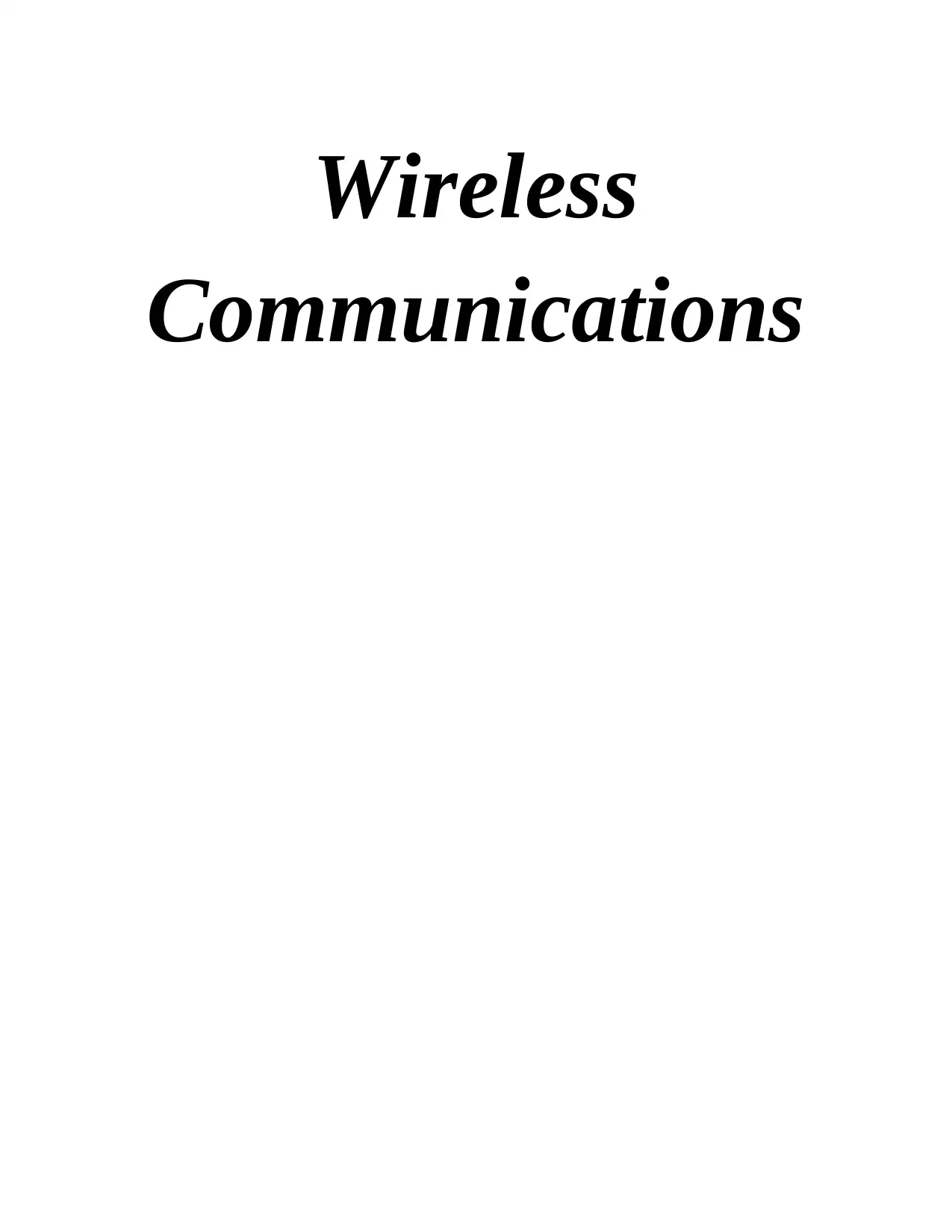
Wireless
Communications
Communications
Paraphrase This Document
Need a fresh take? Get an instant paraphrase of this document with our AI Paraphraser
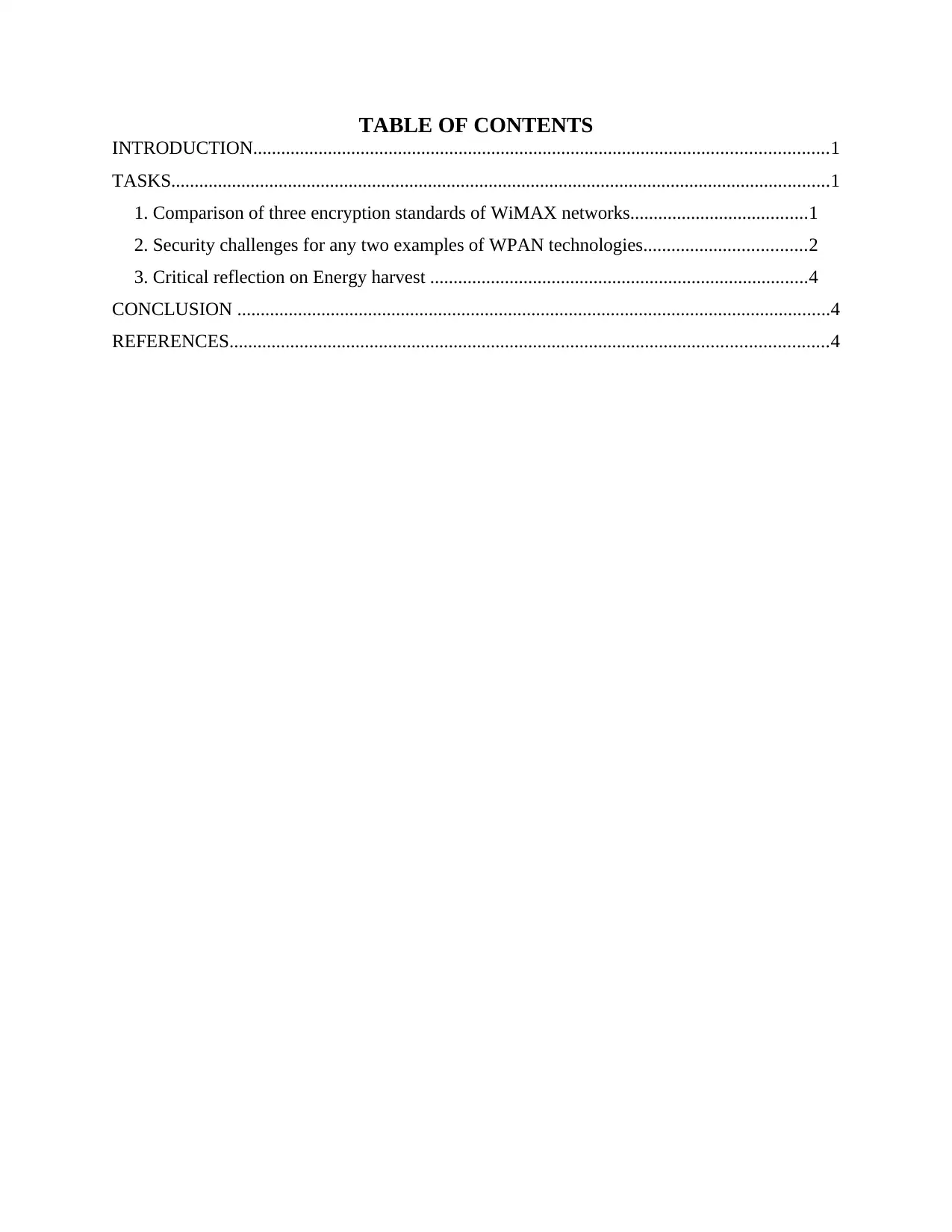
TABLE OF CONTENTS
INTRODUCTION...........................................................................................................................1
TASKS.............................................................................................................................................1
1. Comparison of three encryption standards of WiMAX networks......................................1
2. Security challenges for any two examples of WPAN technologies...................................2
3. Critical reflection on Energy harvest .................................................................................4
CONCLUSION ...............................................................................................................................4
REFERENCES................................................................................................................................4
INTRODUCTION...........................................................................................................................1
TASKS.............................................................................................................................................1
1. Comparison of three encryption standards of WiMAX networks......................................1
2. Security challenges for any two examples of WPAN technologies...................................2
3. Critical reflection on Energy harvest .................................................................................4
CONCLUSION ...............................................................................................................................4
REFERENCES................................................................................................................................4
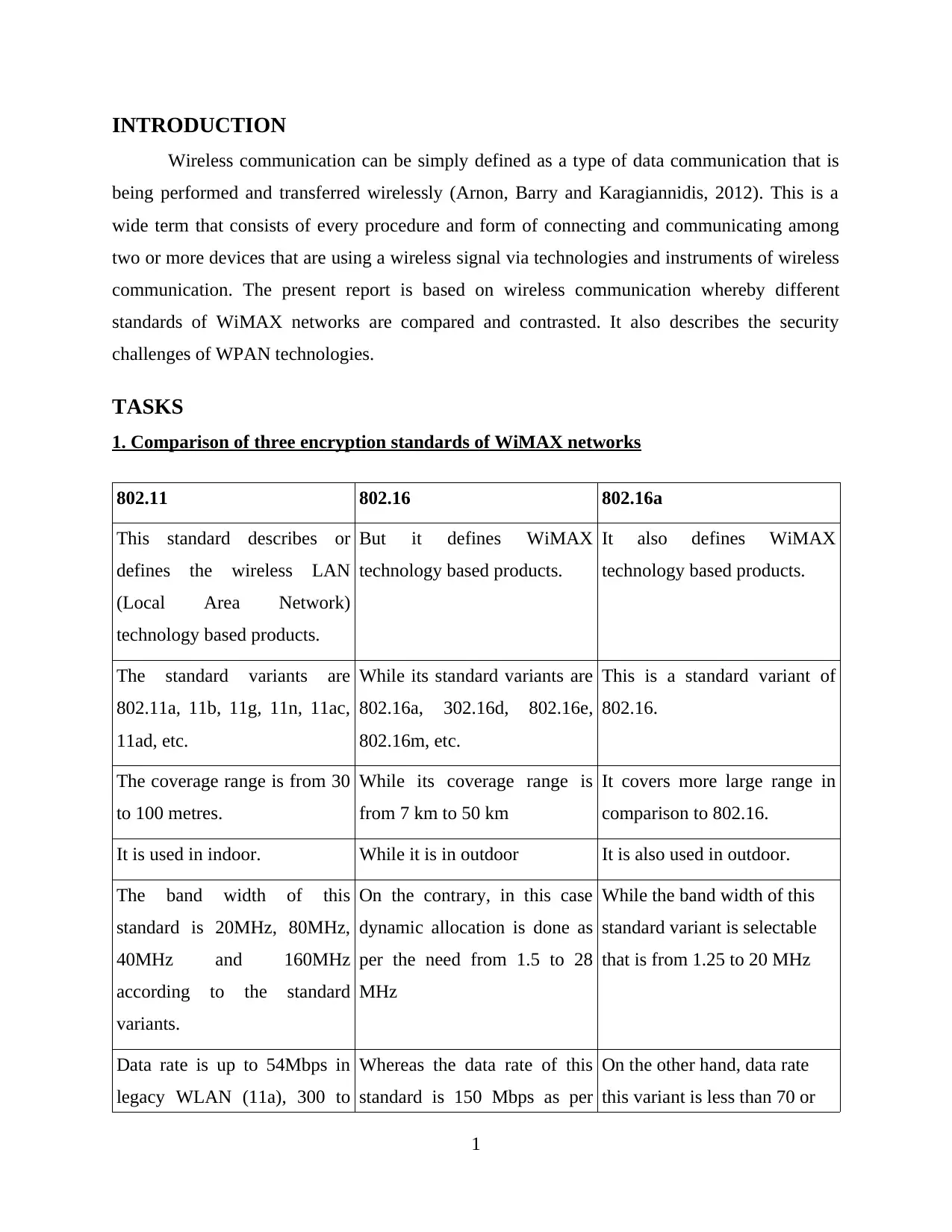
INTRODUCTION
Wireless communication can be simply defined as a type of data communication that is
being performed and transferred wirelessly (Arnon, Barry and Karagiannidis, 2012). This is a
wide term that consists of every procedure and form of connecting and communicating among
two or more devices that are using a wireless signal via technologies and instruments of wireless
communication. The present report is based on wireless communication whereby different
standards of WiMAX networks are compared and contrasted. It also describes the security
challenges of WPAN technologies.
TASKS
1. Comparison of three encryption standards of WiMAX networks
802.11 802.16 802.16a
This standard describes or
defines the wireless LAN
(Local Area Network)
technology based products.
But it defines WiMAX
technology based products.
It also defines WiMAX
technology based products.
The standard variants are
802.11a, 11b, 11g, 11n, 11ac,
11ad, etc.
While its standard variants are
802.16a, 302.16d, 802.16e,
802.16m, etc.
This is a standard variant of
802.16.
The coverage range is from 30
to 100 metres.
While its coverage range is
from 7 km to 50 km
It covers more large range in
comparison to 802.16.
It is used in indoor. While it is in outdoor It is also used in outdoor.
The band width of this
standard is 20MHz, 80MHz,
40MHz and 160MHz
according to the standard
variants.
On the contrary, in this case
dynamic allocation is done as
per the need from 1.5 to 28
MHz
While the band width of this
standard variant is selectable
that is from 1.25 to 20 MHz
Data rate is up to 54Mbps in
legacy WLAN (11a), 300 to
Whereas the data rate of this
standard is 150 Mbps as per
On the other hand, data rate
this variant is less than 70 or
1
Wireless communication can be simply defined as a type of data communication that is
being performed and transferred wirelessly (Arnon, Barry and Karagiannidis, 2012). This is a
wide term that consists of every procedure and form of connecting and communicating among
two or more devices that are using a wireless signal via technologies and instruments of wireless
communication. The present report is based on wireless communication whereby different
standards of WiMAX networks are compared and contrasted. It also describes the security
challenges of WPAN technologies.
TASKS
1. Comparison of three encryption standards of WiMAX networks
802.11 802.16 802.16a
This standard describes or
defines the wireless LAN
(Local Area Network)
technology based products.
But it defines WiMAX
technology based products.
It also defines WiMAX
technology based products.
The standard variants are
802.11a, 11b, 11g, 11n, 11ac,
11ad, etc.
While its standard variants are
802.16a, 302.16d, 802.16e,
802.16m, etc.
This is a standard variant of
802.16.
The coverage range is from 30
to 100 metres.
While its coverage range is
from 7 km to 50 km
It covers more large range in
comparison to 802.16.
It is used in indoor. While it is in outdoor It is also used in outdoor.
The band width of this
standard is 20MHz, 80MHz,
40MHz and 160MHz
according to the standard
variants.
On the contrary, in this case
dynamic allocation is done as
per the need from 1.5 to 28
MHz
While the band width of this
standard variant is selectable
that is from 1.25 to 20 MHz
Data rate is up to 54Mbps in
legacy WLAN (11a), 300 to
Whereas the data rate of this
standard is 150 Mbps as per
On the other hand, data rate
this variant is less than 70 or
1
⊘ This is a preview!⊘
Do you want full access?
Subscribe today to unlock all pages.

Trusted by 1+ million students worldwide
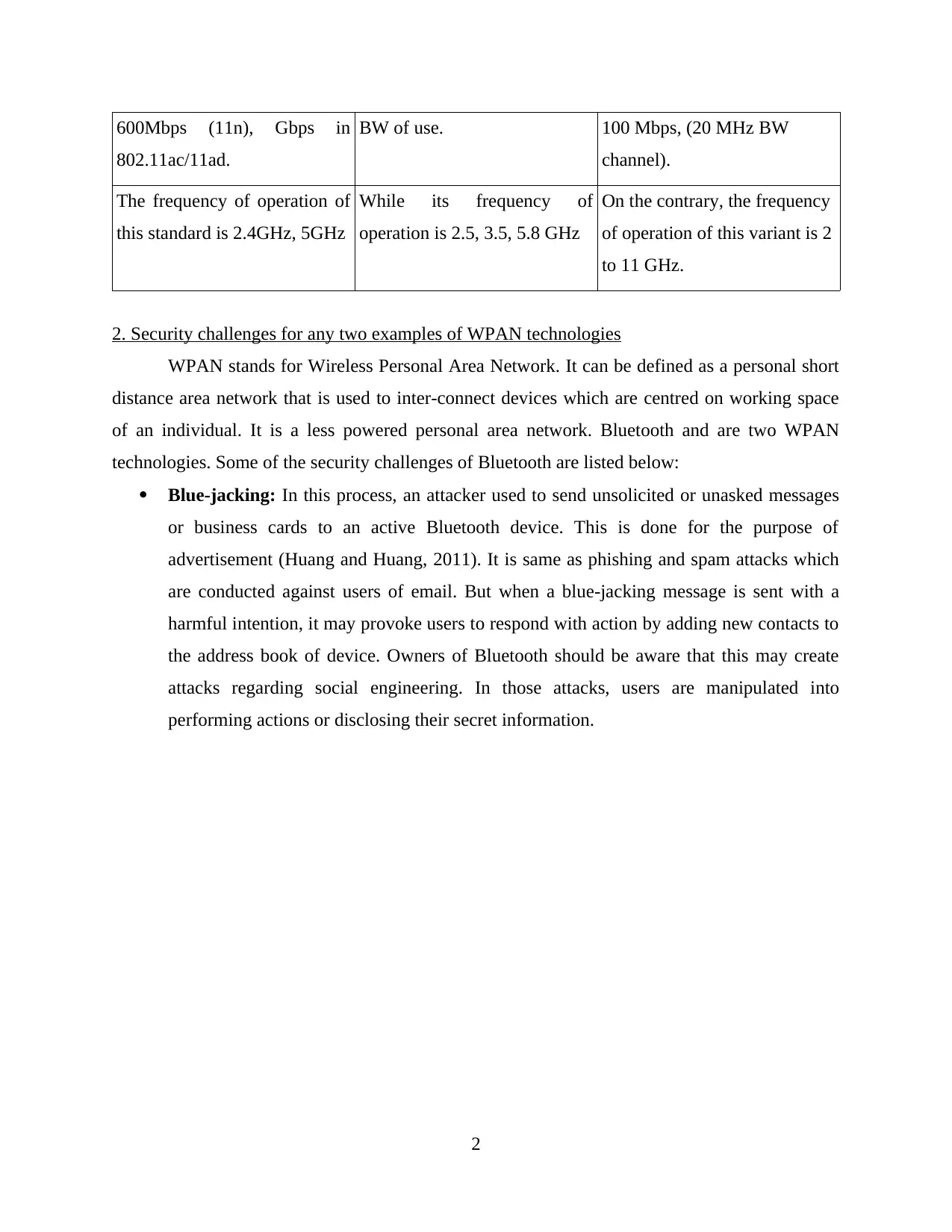
600Mbps (11n), Gbps in
802.11ac/11ad.
BW of use. 100 Mbps, (20 MHz BW
channel).
The frequency of operation of
this standard is 2.4GHz, 5GHz
While its frequency of
operation is 2.5, 3.5, 5.8 GHz
On the contrary, the frequency
of operation of this variant is 2
to 11 GHz.
2. Security challenges for any two examples of WPAN technologies
WPAN stands for Wireless Personal Area Network. It can be defined as a personal short
distance area network that is used to inter-connect devices which are centred on working space
of an individual. It is a less powered personal area network. Bluetooth and are two WPAN
technologies. Some of the security challenges of Bluetooth are listed below:
Blue-jacking: In this process, an attacker used to send unsolicited or unasked messages
or business cards to an active Bluetooth device. This is done for the purpose of
advertisement (Huang and Huang, 2011). It is same as phishing and spam attacks which
are conducted against users of email. But when a blue-jacking message is sent with a
harmful intention, it may provoke users to respond with action by adding new contacts to
the address book of device. Owners of Bluetooth should be aware that this may create
attacks regarding social engineering. In those attacks, users are manipulated into
performing actions or disclosing their secret information.
2
802.11ac/11ad.
BW of use. 100 Mbps, (20 MHz BW
channel).
The frequency of operation of
this standard is 2.4GHz, 5GHz
While its frequency of
operation is 2.5, 3.5, 5.8 GHz
On the contrary, the frequency
of operation of this variant is 2
to 11 GHz.
2. Security challenges for any two examples of WPAN technologies
WPAN stands for Wireless Personal Area Network. It can be defined as a personal short
distance area network that is used to inter-connect devices which are centred on working space
of an individual. It is a less powered personal area network. Bluetooth and are two WPAN
technologies. Some of the security challenges of Bluetooth are listed below:
Blue-jacking: In this process, an attacker used to send unsolicited or unasked messages
or business cards to an active Bluetooth device. This is done for the purpose of
advertisement (Huang and Huang, 2011). It is same as phishing and spam attacks which
are conducted against users of email. But when a blue-jacking message is sent with a
harmful intention, it may provoke users to respond with action by adding new contacts to
the address book of device. Owners of Bluetooth should be aware that this may create
attacks regarding social engineering. In those attacks, users are manipulated into
performing actions or disclosing their secret information.
2
Paraphrase This Document
Need a fresh take? Get an instant paraphrase of this document with our AI Paraphraser
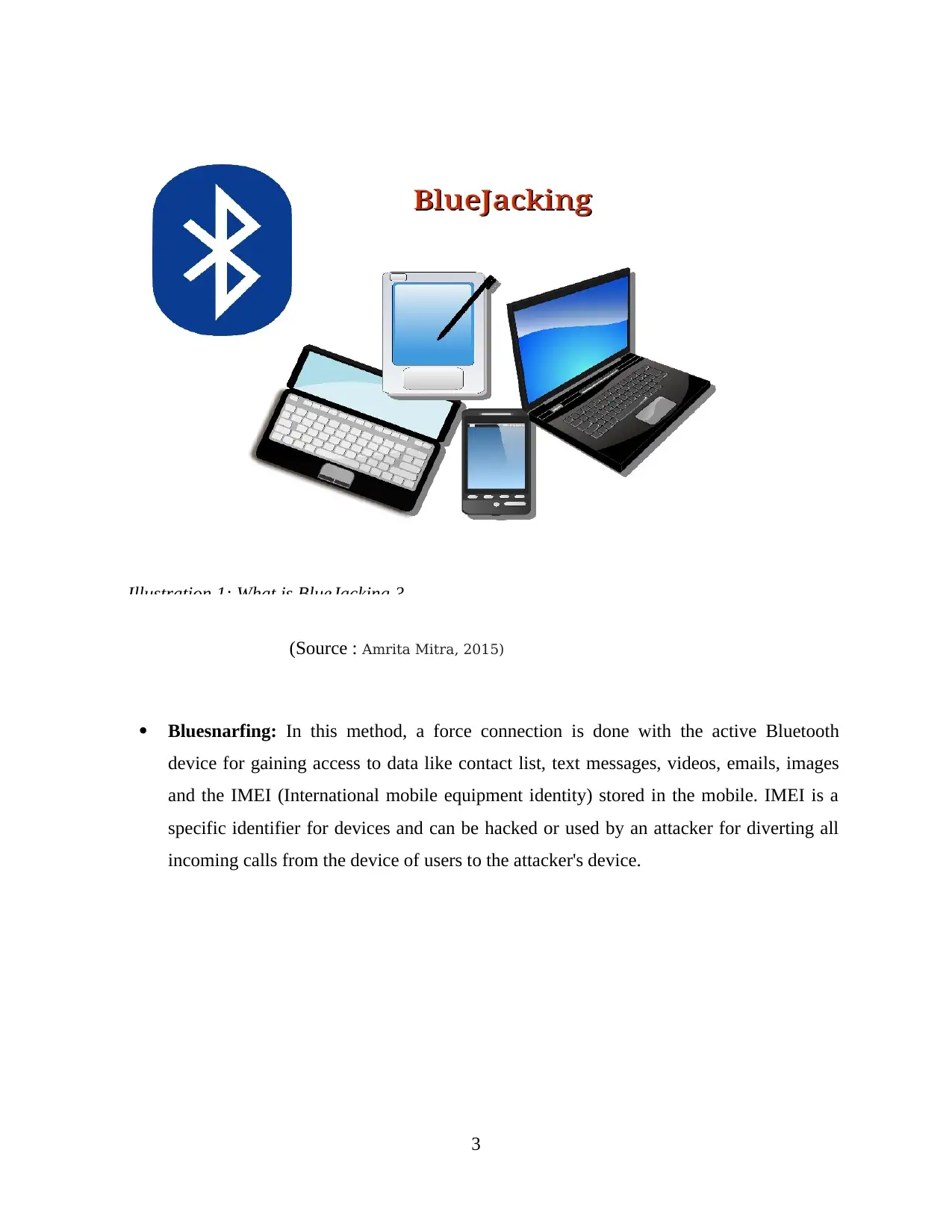
(Source : Amrita Mitra, 2015)
Bluesnarfing: In this method, a force connection is done with the active Bluetooth
device for gaining access to data like contact list, text messages, videos, emails, images
and the IMEI (International mobile equipment identity) stored in the mobile. IMEI is a
specific identifier for devices and can be hacked or used by an attacker for diverting all
incoming calls from the device of users to the attacker's device.
3
Illustration 1: What is BlueJacking ?
Bluesnarfing: In this method, a force connection is done with the active Bluetooth
device for gaining access to data like contact list, text messages, videos, emails, images
and the IMEI (International mobile equipment identity) stored in the mobile. IMEI is a
specific identifier for devices and can be hacked or used by an attacker for diverting all
incoming calls from the device of users to the attacker's device.
3
Illustration 1: What is BlueJacking ?

(Source : Amrita Mitra, 2015)
Blue-smack: This is a Bluetooth Denial of Service attack whereby device that has an
active Bluetooth is overtaken by de-spiteful requests from an attacker (JuneLeung, 2011).
Due to this, it is not operated by its owner. It also causes draining of battery.
Security challenges of ZigBee are described below:
Physical attacks: If an attacker gains physical access to a device containing a ZigBee
radio, they try to obtain their encryption key.
Replay and injection attacks: This is done for tricking the ZigBee device to perform
unauthorized actions. These devices are vulnerable to such attacks as their protocol are
very low or light weight that has very minimum replay protection.
4
Illustration 2: What is BlueSnarfing ?
Blue-smack: This is a Bluetooth Denial of Service attack whereby device that has an
active Bluetooth is overtaken by de-spiteful requests from an attacker (JuneLeung, 2011).
Due to this, it is not operated by its owner. It also causes draining of battery.
Security challenges of ZigBee are described below:
Physical attacks: If an attacker gains physical access to a device containing a ZigBee
radio, they try to obtain their encryption key.
Replay and injection attacks: This is done for tricking the ZigBee device to perform
unauthorized actions. These devices are vulnerable to such attacks as their protocol are
very low or light weight that has very minimum replay protection.
4
Illustration 2: What is BlueSnarfing ?
⊘ This is a preview!⊘
Do you want full access?
Subscribe today to unlock all pages.

Trusted by 1+ million students worldwide

3. Critical reflection on Energy harvest
As per the view point of Makimoto and Yamashita (2013), energy can be harvested for
wireless sensor network by different methods. Some of the methods are described below:
Solar energy: According to Pahlavan and Krishnamurthy (2011), commonly a sensor
node uses energy from nature. It consist of various blocks like energy harvesting module,
the storage unit such as a sensing element, a transmitter, a super capacitor and a micro
controller. On the other hand, Rengaraju, Lung and Srinivasan (2011) says that solar
energy can generate adequate amount of power that is essential for wireless sensors. A
solar panel can be used as an energy harvesting source for the wireless sensors. This
gives direct DC voltage so there is no need of additional circuit rectifications.
Piezoelectricity: Sauter (2011) stated that it is formed from two Greek words i.e. ‘piezo’
which means pressure and ‘electric’ referring to electricity. Major benefit of piezoelectric
material is that they can provide high amount of voltage. In this effect, usable output
voltage can be acquired or received directly from the material and therefore there is no
requirement of applying multi-stage post processing for generating the voltage as per the
wish.
Radio energy: Zhuang and Ismail (2012) thought that the expectation of the harvesting
RF energy, from ambient, make capable wireless charging of a sensor mode. One can
yield energy from radio waves having a transmitter set. On the contrary, Leung (2011)
says that it is achievable for controlling the amount of transferred energy by making it
regular or continuous.
CONCLUSION
From the above report, it can be concluded that in wireless communication, data or
information can be transferred wirelessly. The comparison between three encryption standards of
WiMAX network is done here. Additionally, the security failure or challenges of two
technologies of WPAN that is Bluetooh and ZigBee are also explained here. Energy harvesting
methods include radio and solar energy and Piezoelectricity.
REFERENCES
Books & journals
5
As per the view point of Makimoto and Yamashita (2013), energy can be harvested for
wireless sensor network by different methods. Some of the methods are described below:
Solar energy: According to Pahlavan and Krishnamurthy (2011), commonly a sensor
node uses energy from nature. It consist of various blocks like energy harvesting module,
the storage unit such as a sensing element, a transmitter, a super capacitor and a micro
controller. On the other hand, Rengaraju, Lung and Srinivasan (2011) says that solar
energy can generate adequate amount of power that is essential for wireless sensors. A
solar panel can be used as an energy harvesting source for the wireless sensors. This
gives direct DC voltage so there is no need of additional circuit rectifications.
Piezoelectricity: Sauter (2011) stated that it is formed from two Greek words i.e. ‘piezo’
which means pressure and ‘electric’ referring to electricity. Major benefit of piezoelectric
material is that they can provide high amount of voltage. In this effect, usable output
voltage can be acquired or received directly from the material and therefore there is no
requirement of applying multi-stage post processing for generating the voltage as per the
wish.
Radio energy: Zhuang and Ismail (2012) thought that the expectation of the harvesting
RF energy, from ambient, make capable wireless charging of a sensor mode. One can
yield energy from radio waves having a transmitter set. On the contrary, Leung (2011)
says that it is achievable for controlling the amount of transferred energy by making it
regular or continuous.
CONCLUSION
From the above report, it can be concluded that in wireless communication, data or
information can be transferred wirelessly. The comparison between three encryption standards of
WiMAX network is done here. Additionally, the security failure or challenges of two
technologies of WPAN that is Bluetooh and ZigBee are also explained here. Energy harvesting
methods include radio and solar energy and Piezoelectricity.
REFERENCES
Books & journals
5
Paraphrase This Document
Need a fresh take? Get an instant paraphrase of this document with our AI Paraphraser

Arnon, S., Barry, J. and Karagiannidis, G. eds., 2012. Advanced optical wireless communication
systems. Cambridge university press.
Huang, J. and Huang, C.T., 2011, June. Secure mutual authentication protocols for mobile multi-
hop relay WiMAX networks against rogue base/relay stations. In Communications (ICC),
2011 IEEE International Conference on (pp. 1-5). IEEE.
Leung, B., 2011. VLSI for wireless communication. Springer Science & Business Media.
Makimoto, M. and Yamashita, S., 2013. Microwave resonators and filters for wireless
communication: theory, design and application (Vol. 4). Springer Science & Business
Media.
Pahlavan, K. and Krishnamurthy, P., 2011. Principles of wireless networks: A unified approach.
Prentice Hall PTR.
Rengaraju, P., Lung, C.H. and Srinivasan, A., 2011, June. Measuring and analyzing WiMAX
security and QoS in testbed experiments. In Communications (ICC), 2011 IEEE
International Conference on (pp. 1-5). IEEE.
Sauter, M., 2011. Beyond 3G-Bringing networks, terminals and the web together: LTE, WiMAX,
IMS, 4G Devices and the Mobile Web 2.0. John Wiley & Sons.
Zhuang, W. and Ismail, M., 2012. Cooperation in wireless communication networks. IEEE
Wireless Communications. 19(2). pp.10-20.
Online
Bluetooth Connectivity Threatens Your Security. 2017. [Online]. Available through:
<https://www.kaspersky.com/blog/bluetooth-security/1637/>. [Accessed on 21st
September 2017].
6
systems. Cambridge university press.
Huang, J. and Huang, C.T., 2011, June. Secure mutual authentication protocols for mobile multi-
hop relay WiMAX networks against rogue base/relay stations. In Communications (ICC),
2011 IEEE International Conference on (pp. 1-5). IEEE.
Leung, B., 2011. VLSI for wireless communication. Springer Science & Business Media.
Makimoto, M. and Yamashita, S., 2013. Microwave resonators and filters for wireless
communication: theory, design and application (Vol. 4). Springer Science & Business
Media.
Pahlavan, K. and Krishnamurthy, P., 2011. Principles of wireless networks: A unified approach.
Prentice Hall PTR.
Rengaraju, P., Lung, C.H. and Srinivasan, A., 2011, June. Measuring and analyzing WiMAX
security and QoS in testbed experiments. In Communications (ICC), 2011 IEEE
International Conference on (pp. 1-5). IEEE.
Sauter, M., 2011. Beyond 3G-Bringing networks, terminals and the web together: LTE, WiMAX,
IMS, 4G Devices and the Mobile Web 2.0. John Wiley & Sons.
Zhuang, W. and Ismail, M., 2012. Cooperation in wireless communication networks. IEEE
Wireless Communications. 19(2). pp.10-20.
Online
Bluetooth Connectivity Threatens Your Security. 2017. [Online]. Available through:
<https://www.kaspersky.com/blog/bluetooth-security/1637/>. [Accessed on 21st
September 2017].
6
1 out of 8